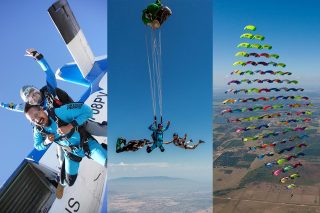Science Class Information - Physics
Physical Science Lesson
Tunnel And Dropzone Tour
Students can participate in: conducting terminal velocity experiments w/ various sports balls, observing how different shapes affect flight stability, viewing a demonstration of how movements affect body flight. Students can experience “bodyflight” at our discount group rate.
Body Flight Educational Program – After your group flight, the tunnel Instructors will demonstrate their flying skills by using every surface of the body!
Dropzone Tour – History of Skydive Perris, Skydiving and Parachute packing, Tandem Demonstration, and watching the airplanes taking off and parachutes landing.
How The Tunnel Works
Fans: – The tunnel works like a giant vacuum cleaner. Five 250 horsepower electric fans draw up the wind through an “Air straightened grid’ producing up to 130 mph winds into a 12 foot wide by 40 foot high hexagon shaped chamber called a Venturi design. The air stream flows in one direction and the temperature inside is determined by the outside atmosphere.
NEWTON’S LAWS OF MOTION – LAW #1: LAW OF INERTIA
An object in motion continues in motion, unless acted upon by an external force. An object at rest tends to stay at rest and an object in motion tends to stay in motion with the same speed and in the same direction, unless acted upon by an unbalanced force.
NEWTON’S LAWS OF MOTION – LAW #2: F=MA
Force = Mass times Acceleration. Heavier objects require more force to move the same distance as lighter objects. Force and acceleration are directly proportional. The greater the force, the greater the acceleration. Mass and acceleration are inversely related. The greater the mass of an object the less the acceleration if the same force is applied.
NEWTON’S LAWS OF MOTION – LAW #3
Law #3: For every action, there is an equal and opposite reaction. This means that forces always occur in pairs. Forces are interactions between objects, like conversations are interactions between people. Single, isolated forces never happen. “Equal” means both forces are exactly the same size. They are equal in magnitude.
Both forces exist at exactly the same time. They both start at exactly the same instant, and they both stop at exactly the same instant. They are equal in time. ”Opposite” means that the two forces always act in opposite directions – exactly 180 degrees apart.
FORCES – WHAT IS FORCE?
A force is a push or pull on something.
TYPES OF FORCE
Push, pull, friction, gravity, electrical-magnetic, strong & weak nuclear tension, normal, air resistance, applied, spring (contact vs. distance). Only a force can change the velocity of an object. So many forces are acting upon you right now, but you aren’t accelerating.
FORCES IN THE WIND TUNNEL – GRAVITY
How does it act? It pulls towards the center of the earth, you also pull on the earth, but it’s not enough for you to actually see it happening.
NET FORCES
An unbalanced force or the sum of all forces acting on a given object. The total force on an object when all of the separate . Forces are added together… Total force used on an object. Net force = Mass times Acceleration. Net force is the vector sum of all forces.
EXAMPLE: Imagine 2 people are pulling on your arms equally, while you are standing you will not move in either direction, you are at equilibrium. Imagine that cn person pulls harder than the other you will go in that direction; you have a net force in that direction. Imagine that the 2nd person stops pulling altogether you will go in that direction, but even faster because no force is holding you back.
NEWTON’S LAWS OF MOTION – FORCES ARE ADDITIVE
Misconceptions of Newton’s Laws Forces don’t necessarily keep objects moving. For instance, the presence of a force has slowed this book down.
FORCES – FRICTION IS
A force which opposes motion, an important force in our lives. We rely on friction in many ways. An athlete usually wears shoes which provide him or her with a greater friction between the shoe and the surface. We rely on friction as an important aspect of our motion. In what other ways does friction play a role in our everyday lives?
AIR RESISTANCE: HOW DOES IT ACT?
This is also called drag. Drag forces act in a direction opposite to the instantaneous velocity. A stone falls faster than a feather. Air resistance affects the stone less. Air resistance is shown in a skydiver with an open parachute. Makes it possible for the skydiver to land at a slower speed. In the tunnel, the mass of an object affects the speed needed to fly an object. The shape of an object affects the way in which object will fly.
TERMINAL VELOCITY – FREEFALL
When a skydiver leaves the aircraft he speeds up because there are unbalanced forces acting. His weight is greater than the fictional drag force. As his speed increases, the fictional drag due to the air increases. Spreading himself like a eagle increases the surface area and increases the fictional drag.
TERMINAL VELOCITY – ACCELERATION
Forces cause objects to accelerate (2nd Law). When the force of gravity on a falling object equals the force of the air resistance going against gravity, the forces balance out and the object stops accelerating. The object will travel at a constant velocity – the terminal velocity.
PHYSICAL SCIENCE – WHAT IS ACCELERATION?
A change in velocity (Direction or speed), Velocity=a change in Distance per change in time. Acceleration Depends on two factors:
- Force – Forces cause objects to accelerate (speed up)
- Mass
TERMINAL VELOCITY – FREEFALL
At a certain speed the two forces are balanced and therefore, the acceleration is zero Terminal velocity is reached when Fdrag = Fgrav (= mg) Reached in about 5 seconds at 120 mph. It actually takes slightly longer because acceleration is reduced as you begin to encounter drag. Freefall only lasts a few seconds (45 sec) for skydivers.
FORCES IN THE TUNNEL – TUNNEL FLIGHT
We are able to begin flying at the same stage that a skydiver would have reached terminal velocity. Terminal Velocity is achieved when the drag force is equal in magnitude but opposite in direction to the force propelling the object F is force, d is drag, and g is gravity.
MOTION IN THE WIND TUNNEL
Equilibrium is achieved when a tunnel flyer is neither arched, nor de-arched.
MOTION IN THE WIND TUNNEL
Every action causes a reaction. Drag is used to affect the way that we can fly.
TUNNEL TOUR – “HOW IT WORKS” EXPERIMENTAL PORTION
Students will participate in: conducting terminal velocity experiments w/ various sports balls, observing how different shapes affect flight stability, and viewing a demonstration of how movements affect body flight.
FRICTION – WHAT CAUSES FRICTION?
There are two factors which affect friction between two surfaces: Kind of surfaces in contact (rough or smooth) Amount of force pressing the surfaces together. The rougher the surface and the stronger the force between the surfaces, the greater the amount of friction.
AIR RESISTANCE
Another type of friction is air resistance Air resistance is a force which opposes a moving object. This can be easily seen with falling objects. When a piece of paper and a crumbled piece of the same paper are dropped, they fall at the same rate. A penny and a feather dropped in air will not fall at the same rate, but a penny and feather dropped in a vacuum (no air) will.
BODY FLIGHT EDUCATIONAL PROGRAM
After your flight Tunnel Instructors demo. Enjoy your flights!




